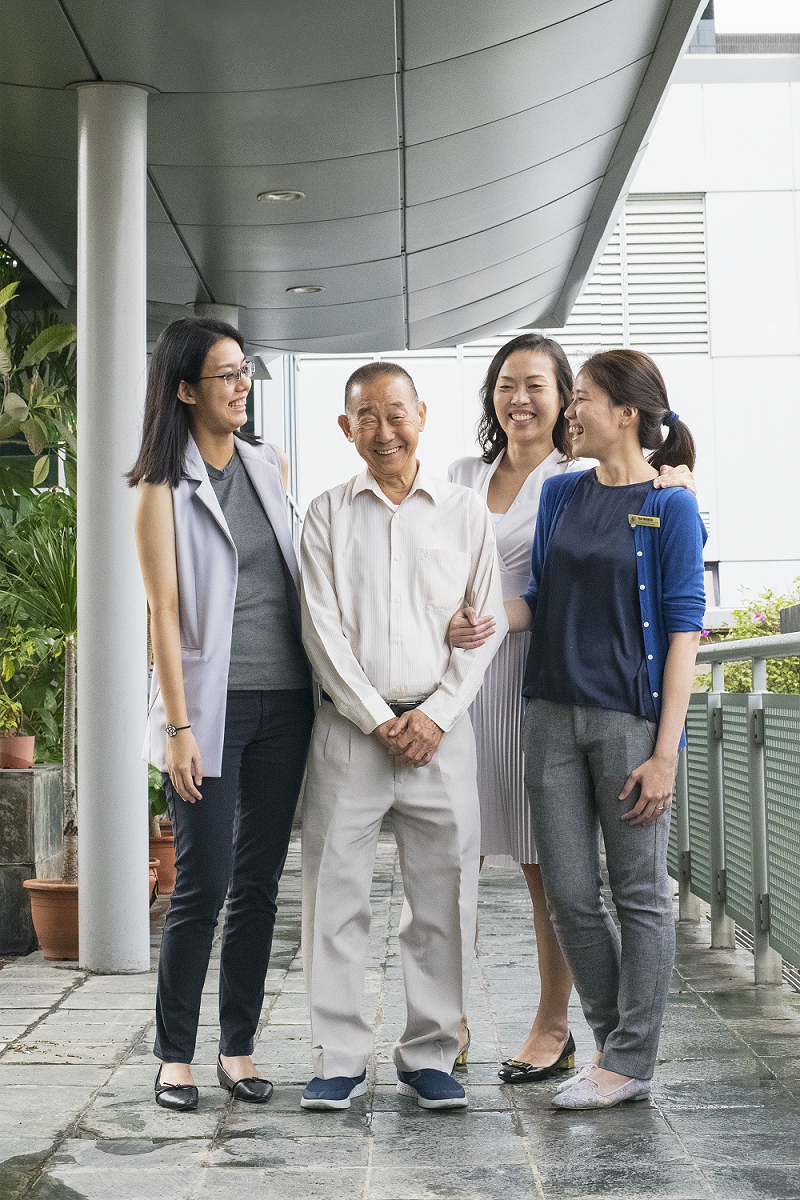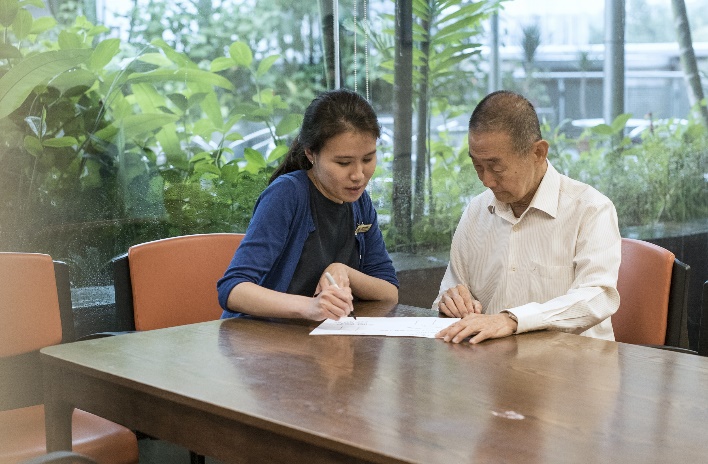OTs Yanwen and Joy take special interest in helping elderly with restricted vision live active lives.
For the past 11 years, 76-year-old Joseph Ong has been taking a bus to the polyclinic almost daily to serve as a volunteer for hundreds of patients who are there for medical appointments.
The spritely senior talks to patients, brings cheer to those who are unwell and guides them to the correct places, just like any volunteer.
However, what is not visible is this: Mr Ong has low vision. He cannot see well due to the loss of peripheral vision as a result of glaucoma. He also has problems seeing in low light conditions.

Mr Joseph Ong with Senior Occupational Therapist Tan Yanwen (right) from SGH, Medical Social Worker Candice Ow and Principal Optometrist Lisa Ong from SNEC.
Low vision is commonly defined as visual impairment that cannot be corrected by prescriptive glasses or medical intervention, and that hinders daily activities.
In April 2017, things started looking up for Mr Ong when his doctor at the Singapore National Eye Centre referred him to an occupational therapist in SGH, under a new programme to help seniors learn how to cope with restricted vision.
Senior OT Tan Yanwen became Mr Ong’s therapist. “Mr Ong’s main difficulty was bumping into people and objects,” explained Yanwen. “My role was to help him fine-tune his skills. As he is an active volunteer, he has to learn to stay safe in a community environment. The skills include, for example, judging steps, scanning the environment and being more mindful of the different environmental features.”
As part of his session with Yanwen, Mr Ong learnt visual scanning strategies and how to turn his head to check his ‘blind spots’. These are especially useful in a crowded situation, important for an active senior like him.


Yanwen first taught Mr Ong visual scanning strategies on paper, before bringing him into a community setting to practise these strategies.
Yanwen and Joy Heng are the only two OTs in the multi-disciplinary Low Vision Clinic. Both of them took a special interest in low vision because of their own clinical experiences with patients with this condition. Yanwen shared, “When I was a new therapist covering patients in the medical wards, I met this low vision patient who also had chronic renal failure. She taught me that it was possible to be independent in daily activities with proper training and a period of adaptation although she was afflicted by many different conditions, including near total blindness. It was also at about the same time in 2013 that SGH OT Department and SNEC Low Vision Clinic identified the need to do more for this group of patients.”
For Joy, “it started from noticing how visual activities were often given less priority by medical teams at inpatient levels, as it is not a ‘visible’ impairment like muscle weakness. Patients frequently get admitted for reasons that can be attributed to poor vision as well, such as falls and medication-related challenges.”
“Besides learning functional skills, low vision patients have to contend with the grief of losing their sight, fear of coping with limited vision and the stigma of ‘going blind’. Visual impairment is ‘hidden’, and family and caregivers may not fully appreciate what low vision patients are experiencing as many of them may appear physically well in spite of their conditions. These add to the patient’s woes, which can lead to depression. Therefore, it is important for us to work closely with medical social workers so they can attend to the seniors’ emotional needs,” explained Yanwen.
Ultimately, a positive attitude can help the low vision patient adjust to his condition. Perhaps no one can give better advice than Mr Ong: “Don’t be afraid, but go and see a doctor quickly. If you feel better in your heart, you will be better!”
The Senior Eye Rehabilitation Programme introduced in SGH and SNEC is supported by the Temasek Cares Foundation. This story is adapted from a blog article by Temasek Cares Foundation on SEER Programme.
We love mail! Drop us a note at [email protected] to tell us what you like or didn’t like about this story, and what you would like to see more of in LighterNotes.
